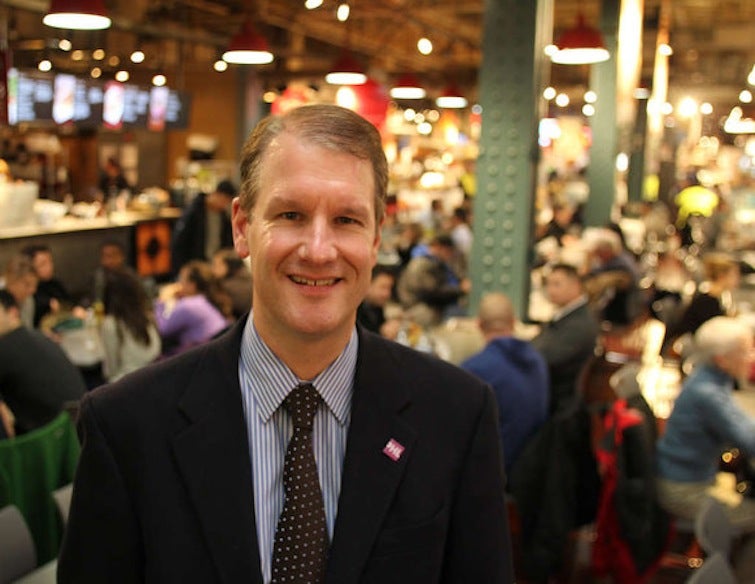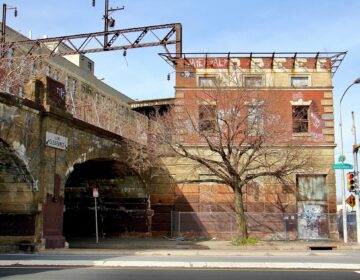On the Record: Q&A with Paul Steinke on the state of preservation in Philly

Paul Steinke’s first few months at the helm of the Preservation Alliance for Greater Philadelphia have been more exciting than he, or anyone else, anticipated. After less than two months on the job, the news broke that a corner of Jewelers’ Row could soon face the wrecking ball. Since then Steinke and the Alliance have been at the forefront of the fight to save this historic and beloved corner of Center City. But this is hardly his first turn in the public eye.
For the past three decades Steinke has been an omnipresent presence in some of Philadelphia’s most influential new institutions. He got his start under Paul Levy at the Center City District, before becoming the first executive director of the University City District, and then the general manager of the beloved Reading Terminal Market as it became a stable and prosperous enterprise. For much of that time Steinke also played a role in the historic preservation movement, serving on the board of the Alliance from 1996 until 2006 and again from 2013 until he started his current position. During the years in between he served as the treasurer of Preservation Pennsylvania. When he lost his bid for an at-large seat on city council, it made sense that preservation work would become his mainstay. But no one could have predicted—except perhaps Toll Brothers—how quickly his new position would catapult him into the limelight.
PlanPhilly caught up with Steinke, and his advocacy director Patrick Grossi, in the Preservation Alliance’s tiny Center City headquarters off of Walnut Street. The office is decorated with drawings of old buildings, sweeping photographs by the son of longtime Alliance president John Gallery, and old preservationist propaganda (“Citizens of Philadelphia, Show You Care About Lits”).
The following Q&A has been edited. If you prefer, read the full transcript here.
PlanPhilly: You had only been the head of the Preservation Alliance for a couple months when the Jewelers’ Row news broke. Since then you’ve been one of the principal champions of the cause. But at this point, legally, Toll Brothers appears to have the upper hand. The chief advantage you have is basically public outrage. Will that be enough?
Steinke: I don’t know. Another positive outcome, no matter what happens with Jewelers’ Row, is that this is focusing energy and attention on how the city’s regulatory environment is not favorable to preservation. There are a number of cities that have demolition review or demolition delay, if a demolition permit is sought for a property that is more than 50 years old and/or on the National Register there is a mechanism to slow the process down and evaluate whether that building deserves to be landmarked.
Cities like Boston, Chicago, and San Antonio, all big cities, have this. So do a host of smaller cities like Concord, Massachusetts and Keene, New Hampshire. If that had been in place on Jewelers’ Row, this wouldn’t be happening because four of the five buildings that are threatened are listed as contributing to National Register District. If we had [this kind of] historical review, this would have been before the Historical Commission right now. Especially because similar but not as high profile cases have been happening citywide for months, if not years. There was the loss of the former Please Touch Museum, definitely a National Register eligible building even though it’s not listed. The Union Baptist church where Marian Anderson sang in the choir would not necessarily have been lost. Instead they were both lost as a by right. No review, no notice. They just became a pile of rubble.
Jewelers’ Row is an opportunity to have the conversation about strengthening our Historical Commission, which under the city charter has the responsibility to identify and preserve the city’s architectural and cultural heritage. But they have been so badly underfunded for so long that buildings like Please Touch and Jewelers’ Row haven’t been locally designated. They have not completed a new historic district since 2010. There are three large pending districts that been in limbo since then. Washington Square West, Overbrook Farms, and Spruce Hill—where we are seeing intact, occupied, income-producing late-19th century buildings being demolished as a right because there are no protections….Why aren’t people angry?
What actions could City Council take to prevent a threat of this magnitude from occurring again? What actions could the Kenney administration take without City Council?
Steinke: Immediately possible is strengthening the Historical Commission so they can fulfill their responsibilities under the city charter to protect and promote our history. Our Historical Commission as it exists doesn’t do much of that at all. The commission needs to be strengthened so more buildings can be designated. The number of buildings designated in the last decade are pitiful. It numbers in the dozens not in the thousands that it could or should be, especially if districts were happening. The Kenney administration and council working together could devote more of the city’s budget to this problem and have a big impact really quickly.
Patrick Grossi: We also don’t have any strong local incentive problems for rehab and preservation. You can get a tax abatement for rehab on improvement for an existing property, but that abatement pales in comparison to what you can get for a new construction project. So for all the development the ten-year tax abatement successfully generates, it’s also inadvertently unveiled the demolition of intact occupied properties.
The city needs to ask itself if the tax abatement is to encourage residential development why are we seeing occupied residential buildings being torn down for new residential buildings? That really wasn’t the intent. The intent was to incentivize new construction to add to the supply and to rehab. But when a developer, like on the 4000-block of Chestnut Street, is confronted with fully taxable and occupied apartment building there’s a real incentive to knock it down and get a tax abatement on the whole thing and build more densely because the zoning code allows it.
Steinke: It’s damaging the city’s character and making us another Bensalem or Phoenix or Houston. I live in Philadelphia, I want it to look like Philadelphia.
I want new construction. There’s great projects going up on parking lots all over town. I’ve been dreaming of that for years. But we are starting to consume our own young. When the things that draw people to city living start to be sacrificed so we can have more city living, we’ve crossed a line. And that’s what’s happening on Jewelers’ Row.
How regularly have you been in touch with the Kenney administration about Jewelers’ Row? Although he promoted the cause of preservation on council to an extent, his first budget didn’t show much evidence of interest. In your conversations with Mayor Kenney have you received any indication of whether the recent crisis will inspire him to fight for a funding infusion for the Historical Commission?
Steinke: One of my first stops after I got started in June was to meet with Anne Fadullon [director of planning and development] and Jon Farnham [executive director of the Historical Commission]. We put some of these ideas on the table then and we talked about some of the recent losses. We got a receptive hearing but no commitments.
We made it a priority to open those lines of communication early, then once the Jewelers’ Row crisis hit we doubled down on those efforts. I notified her [Fadullon] that she would be the target of our petition and I do believe she appreciated that. We invited her to our monthly advocacy committee meeting and she did attend, sat right in that chair over there. She did the walk through with Jewelers’ Row with the Toll Brothers representatives and two members of our board. I’ve been emailing with her several times a week. Where is it leading? I think there is a willingness to sit down and have a discussion about the Jewelers’ Row issue very soon. It’s not confirmed yet, but I think that after Labor Day we can move towards that.
What about in terms of allies on City Council?
Steinke: We’ve set a goal to meet with every person on council before the end of the year. They are all important, especially the district council people because they have territory. We’ve meet with Mark Squilla. We would seriously like to talk with Maria Quiñones-Sánchez because of her role with the Land Bank as well as the fact that she is the appropriations chair on council. We think Cindy Bass is an important player because her district includes Germantown. Outside Center City, Germantown may be the most historic area of the city and in some ways it has long been one of the more troubled, so it is really important. And you can never forget the Council President of course; he has a big chunk of the center and northern parts of the city. But eventually we want to hit them all.
What other cities do you look to as a model for historic preservation policy?
Grossi: Something we haven’t really talked about yet is a citywide inventory of historic spaces. That map doesn’t exist for Philadelphia. It’s a heavy lift. It would require a lot of money.
PlanPhilly: How much money?
Steinke: L.A. is a good example. The Getty Foundation funded it in L.A. We’re talking like $10 million. And it took ten years.
It’s important to do. And the presentation community has been talking about it for at least 35 years that I know of. Demolition review is a way to stop the bleeding before you reach that promised land. I think this is short term. Longer term is to get the inventory done. But it’s a huge city and more than half a million properties with only 3 percent currently protected.
You know where I live [Garden Court in West Philly], that neighborhood was built as a piece by a single developer. If the guy on the end of the block decides he’s unhappy with that house built in 1921 he could by right go in and get a demo permit and build a new house there. It’s a National Register Historic District where I live, but there are no protections from demolition. That’s the kind of thing cities like Dallas have been dealing with for decades.
Dallas has been a high growth city for a long time and Philly hadn’t been a high growth city since before the Great Depression….We’ve been dealing with blight for most of our lives. We haven’t had to deal with this before.
Grossi: On the incentive end, Baltimore is doing a much better job than we are. They have invectives at the state and local municipal level that essentially mirror the existing federal rehabilitation tax credits. If a resource strapped city like Baltimore can provide that, we should be able to too. It’s a little different than Baltimore because we are experiencing growth for the first time in a while. Baltimore is using preservation as a way to welcome growth and development. Going back to the 1990s, Los Angeles has a really successful adaptive reuse ordinance. It’s more of a procedural incentive program, but it has driven the conversion of a lot of downtown office and industrial buildings into residential units. And that’s totally plausible here.
You started working with Paul Levy at a time when downtown was in a much different state. Some critics of historic preservation have argued that it’s almost a form of NIMBYism, and that it comes into conflict with the kind of economic development the Center City District is all about. Or as you put it in a Philly Mag article, our most pressing issue is that Philly has too little “employment, taxable businesses and taxable real estate.” How does historic preservation address those issues?
Steinke: The simplistic answer is buy yourself a plane ticket to Boston or San Francisco. Look at the way they have incorporated the old with the new in these thriving, vibrant cities. They are in the top tier of American cities. Philly has been striving my entire life to get into that echelon. The built environment of those cities is key to their appeal and so is ours. Those two cities have done a really good job taking care of it and people love it.
Grossi: Unlike Boston and San Francisco, because of the expansive nature of our city we can increase the housing supply here while still doing what Boston and San Francisco do. Those are two cities really struggling with [providing enough new housing] and sometimes preservation is really blamed for it. But we are uniquely positioned to avoid those pitfalls while still preserving the historic environment.
Paul you were at the head of Reading Terminal market from 2000 until 2014. At a recent meeting with the Washington Square West Civic Association on the Jewelers’ Row crisis, you cited the successful intervention to save Reading Terminal in the early 1990s as an inspirational example. What was your role in that fight and what practical lessons can be applied to Jewelers’ Row or other preservation battlegrounds?
Steinke: It was a miracle they kept it going, but they did because there was public demand that they do so. The convention center authority was formed and decided, among several choices, to build at 12th and Arch. There was an immediate reaction from the merchants and the public to save the market. Because the convention center wanted to shut it down for three years to rehabilitate it…. But the community, both the merchants and the customers, said this market is important to our quality of life and the quality of life of the city. So the council and the mayor stepped in to pass ordinances governing policies and procedures. The convention center authority put $30 million into a top to bottom renovation of the market, while it was still open. And the policy, making sure it was all still locally owned and operated was enshrined in the agreement, so there couldn’t be any chains or franchises. Then the historical commission worked very closely with the contractors to preserve as much of the original interior as possible.
I think there are a lot of lessons for this moment. When you have a collection of independent local businesses that thrive on proximity that’s something that should be valued and supported and promoted. On Jewelers’ Row I think we’re learning there hasn’t been a whole lot of that. It’s there. But we take it for granted and I don’t see any overt effort to organize by the merchants. There’s an association, but it’s a little informal. Nor do I see any recognition or effort by the city to strengthen it. And it’s not just a shopping district but a manufacturing district. Patrick and I have been in all sorts of shops down there, doing things you’d be shocked to know are going on.
As evidenced by our discussion so far, much of the preservation energy in Philadelphia has been focused in and around Center City. The issues confronting historic buildings in more far-flung neighborhoods are far different, divestment instead of gentrification. There can almost be a preservation by neglect, but that probably isn’t sustainable. How do you hope to address those neighborhoods?
Steinke: The alliance has tried to address those issues over the years with discreet grant-funded projects that address landmarks in outlying neighborhoods, like the Joe Frazier Gym, which we helped get on the national and local register. The John Coltrane House, which we helped get on the local register. The Dox Thrash House up in Sharswood. Patrick worked on a project in Mantua before he started with The Alliance and kept those relationships going.
We have also looked at a possibility of starting a revolving fund for historic properties so that homeowners or maybe commercial property owners could access low interest funds for restorations of their historic buildings. Then they would pay them back once the restorations are complete and the buildings start to generate income or the homeowners have mortgages. So there are tactics we have explored and are exploring because preservation is relevant citywide. Every neighborhood has one or more landmarks people are proud of. Every neighborhood has a certain historic character that’s important to their own sense of self-worth and being. One of the challenges is to highlight those and help those neighborhoods preserve those landmarks and streetscapes.
WHYY is your source for fact-based, in-depth journalism and information. As a nonprofit organization, we rely on financial support from readers like you. Please give today.





